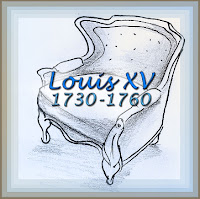When we think Middle-Ages we think of elaborate Gothic thrones or spacious Cathedrals with colossal rib vaults. Such an environment would be that of the wealthy and powerful but the living places of the common people were actually very simplified. Their houses consisted of one or two rooms, dirt floors and bare walls. Tapestries were important for providing insulation on the walls. Chests and benches with storage gave the flexibility of movable storage. Popular furniture pieces for the time included trestle tables, benches, stools and sideboards.
Furniture became more massive and geometric. Elaborate carvings were less used. Spiral and bead turning appeared. The ‘Os de Mouton’ (sheep bone) chairs are a great example of the LXIII style with its spiral curving stretcher. Popular furniture pieces included tall cupboards, chairs with arms and upholstered seating.
Known as the ‘Sun King’, Louis XIV introduced more rich ornamentation using much more costly materials like precious woods, marquetry, gilding and silver. Motifs like mythological creatures, cornucopia, fleurs-de-lis’, scallop shells and many others were often used for many pieces. The commode and console became popular. Legs of chairs became figural mimicking claws.
This is a transition period between Louis XIV and Louis XV. Chairs began having more rounded seats and semi circular backs. Wardrobes had longer legs. Pieces began to look slimmer and lighter. Cane chairs without stretchers emerged.
There was a focus on curving forms and comfortable seating. Chairs had upholstered seats, backs, and arms. Popular furniture included the Bergere (upholstered and enclosed armchair), canapé (small upholstered sofa), chaise lounge and roll top desks. Pieces became comfortable, functional and designed for smaller and more intimate spaces.
The Louis XVI style became more simplified and anticipated the styles of the coming Empire period. Pieces were less extravagant and consisted of more stiff forms and straight lines. Towards the end of the Directoire period Napoleon I came into power. During this time a sub-period appeared called the Consulate style. This focused more on Egyptian motifs which can be seen during the coming period.
Napoleon I campaigns inspired much of the furniture styles of this period. While pieces remained rectilinear embellishments and figural carvings and accents increased. Console legs were often carved as animal feet and consoles were decorated with medallions of heroic figures or mythological creatures.
Furniture still kept much of the previous period’s qualities with less decoration and lighter woods. Dark marquetry on light wood and use of three legged tables and chairs were popular.
The furniture during this time was much like that of the Restoration style. However there was a focus on darker colors and comfort. Table and commodes often had dark marble tops and curved feet.
There was a revival of historic styles from Gothic and Renaissance to Louis XIV, Louis XV and Louis XVI. With the technological advances of the Industrial Revolution craftsmen were able to make gorgeous reproductions. Gilding, veneering and marquetry were among some of the popular techniques during this time.
Completely unlike the preceding style, Art Deco was much more simplified. Furniture was sophisticated and elegant. Pieces consisted of bold geometric forms and used elements that suggested modern technological developments like chrome-plating and use of stainless steel and aluminum.
This was an extension of the Art Deco style. Furniture was functional and minimalistic with a focus on comfort and aesthetics.















